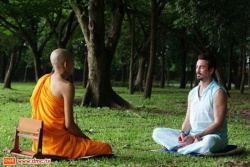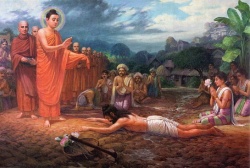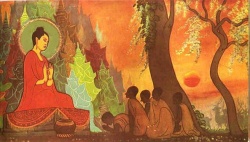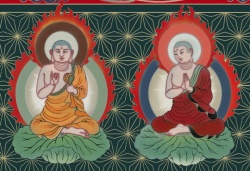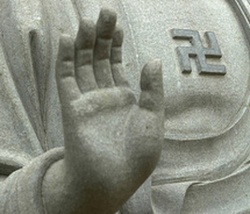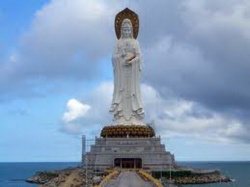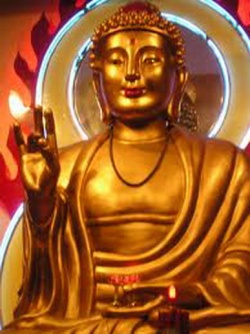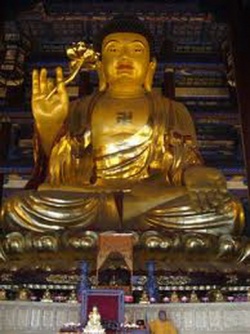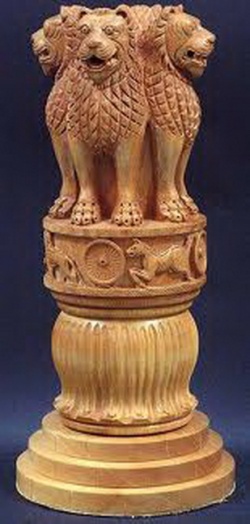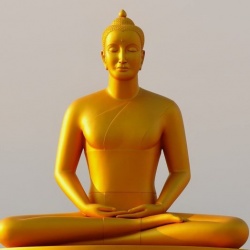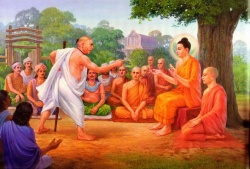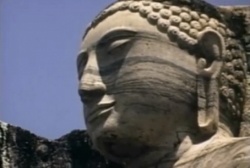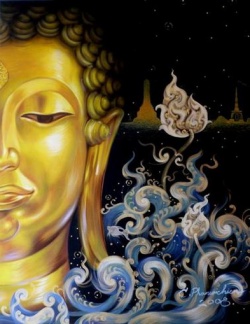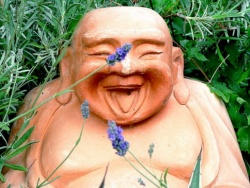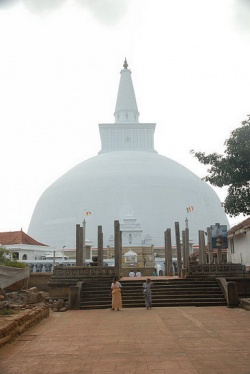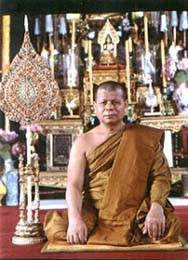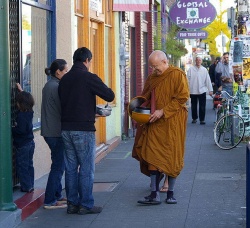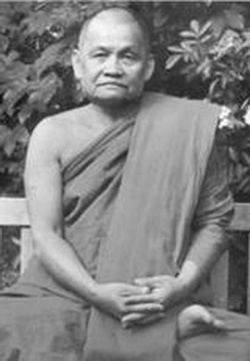Why Devadatta Was No Saint
By Bhikkhu Sujato
Abstract
Devadatta is depicted as the archetypal villain in all Buddhist traditions. Reginald Ray has argued for a radical reassessment of Devadatta as a forest saint who was unfairly maligned in later monastic Buddhism. His work has been influential, but it relies on omissions and mistaken readings of the sources. Ray’s claim that ‘there is no overlap between the Mahāsaṅghika treatment
of [[[Devadatta]]]] and that of the five Sthavira schools’ is untrue. On the contrary, the manner in which Devadatta is depicted in the Mahāsaṅghika is broadly similar to the Sthavira accounts. Such differences as do exist are literary rather than doctrinal. The stories of Devadatta’s depravity became increasingly lurid in later Buddhism, but this is a normal feature of the mythologizing pro
cess, and has nothing to do with any antagonism against forest ascetics. In any case, the early sources are unanimous in condemning Devadatta as the instigator of the first schism in the Buddhist community.
Introduction
In 1994 Reginald Ray published Buddhist Saints in India, a lengthy book on the ‘forest saint’ of Buddhist literature. It told of how the wild, unpredictable sage of the forest was the original Buddhist ideal of sainthood, or arahantship, but was supplanted by the sedate, rule-bound monastics of later years. This romantic tale was
supported by an extensive framework of scholarship.
There is something to this idea, and Ray was right to emphasize the importance of the forest sage. The
tension between the life of meditative seclusion in the forest and settled monasticism in the city is still felt in Buddhist cultures today, and Ray does much to bring the sometimes obscure forest life back into focus.
Nevertheless, Ray fell into the all-too-common trap of over-dramatizing his thesis. It wasn’t enough to simply highlight the role of the forest sages; he had to reconstruct Buddhist history as a vast movement dedicated to suppressing these iconoclastic, charismatic heroes. Given the anti-establishment roots of Western Buddhism, such radical notions will always find eager ears, despite his flawed handling of history.
These flaws are nowhere more apparent than in his astonishing rehabilitation of the so-called ‘condemned saint’, Devadatta. This meme has had a surprising tenacity. It is repeated as if it were authoritative, and is used as a basis for further arguments on anything from vegetarianism to the authenticity of monastic life.1 But it is wrong, and I would like to show why.
Ray’s argument relies on two studies, by Mukherjee and Bareau. I do not have access to these, so my criticisms are not of them, but rather of the way they have been used by Ray.
Devadatta wasn’t all bad
Ray starts by recounting the traditional version of Devadatta’s story, saying he is depicted as an ‘inveterate evildoer’. He argues that the traditions’ bias against Devadatta as an ascetic forest saint influenced them to create ever more lurid accounts of
Devadatta’s evil deeds. He goes on to acknowledge that Devadatta’s position as an evildoer is not entirely consistent, giving a few examples where he appears in a more positive light.
Ray seems to think that these two perspectives are contradictory. But they are nothing of the sort. The story of Devadatta is not that of an ‘inveterate evildoer’, but of a fall from grace: a talented meditator with psychic powers, who became corrupted by jealousy and greed, and committed many bad deeds, before finally seeking redemption.
Devadatta’s good qualities are required by the doctrine of kamma. Power in this life can only come from good kamma in past lives. The Buddha could not have been threatened by a nobody. His adversary must have been someone whose birth was
as exalted as the Buddha’s, who was talented in the mundane achievements of concentration and psychic powers—but not in the stages of Awakening—someone so charismatic he could sway a powerful king to his will. In other words, it had to be someone like Devadatta.
If early versions of Devadatta’s life contained no good qualities, the traditions would have had to invent them. So alongside the increasingly implausible list of crimes attributed to Devadatta, we also find implausible strengths. Literally: the Pali commentaries say Devadatta had the strength of five elephants.2
The real doctrinal problem is, why are there not more texts that show how Devadatta became so powerful? This is a serious problem for the doctrine of kamma, given that Devadatta’s misdeeds are recorded at such length in so many past lives. The problem is addressed at length in the Milindapañha, where King Milinda lists a multitude of Devadatta’s fortunate births, and asks
Nāgasena how to explain this. Nāgasena says that when Devadatta had been a ruler he had protected the land, built bridges and halls, and had been generous to ascetics and those in need.3 The traditions were well aware that Devadatta had some good in him.
However, even though most references to a ‘good’ Devadatta are unproblematic, indeed essential to the story, one of Ray’s examples of the good Devadatta (1624 ) cannot be explained in this way. Ray refers to a passage in the Pali Udāna, which lists Devadatta
alongside several great monks, calling them ‘brahmans’ and, in the verse that follows, claiming that they are arahants. If Devadatta was an arahant it would be impossible for him to commit the crimes that are attributed to him.
Ray’s source is Woodward’s outdated translation, based on the Pali Text Society edition of the Udāna. The PTS edition is, however, the only modern edition I have found that mentions Devadatta in this list. The Royal Thai, [[Sinhala Buddha Jayanthi, and
Chaṭṭha Saṅgāyana (Burmese) editions all omit Devadatta.5 Curiously, the PTS edition does not even mention any variant readings. Obviously this is a mistake. More recent translations by Ireland6 and Thanissaro7 note this, and omit the reference to Devadatta.
This is typical of Ray’s sloppy use of primary texts. He seems to have not read the texts he refers to, and his third-hand descriptions often bear little resemblance to what they actually say. For example, he claims, rather portentously, that in the Aṅguttara Nikāya Devadatta ‘reveals himself as one who has the right view and can preach the correct doctrine’. Ray gives no reference for this startling revelation; and in fact no such text exists. Devadatta does not even speak in the Aṅguttara Nikāya.8
Even when Ray gets the text right, he misrepresents the meaning. He says that Sāriputta praised Devadatta’s saintliness, a praise that is confirmed by the Buddha himself. What he omits is the context.9 When Devadatta’s behavior got out of control, the Buddha asked
Sāriputta to inform the lay folk what was going on.10 Sāriputta says that he had formerly praised Devadatta for his great abilities; the Buddha said that that was true then, and it is true now that Devadatta has changed. This is typical of the way Ray picks and chooses from his sources, in the process twisting their meaning so they become unrecognizable.
Ray further argues (163) that Devadatta appears with the characteristics of a saint ‘even when the texts are openly hostile to him. For example, he is depicted as one who meditates in solitude.’ But the passage he refers to does not depict Devadatta as meditating in solitude, although some translations might be taken to imply so.11 The relevant term rahogatassa paṭisallīnassa simply means ‘in
private, alone’, and has nothing to do with being on a secluded meditation retreat. Under this standard, anyone who spends time thinking alone in their bedroom would qualify as a ‘forest saint’!
In the same paragraph, Ray says that ‘Devadatta is also a realized master and, through his awakening, is in possession of magical power.’ This directly contradicts the Pali text, which says that Devadatta attained the ‘unenlightened person’s psychic
powers’.12 Ray misunderstands the elementary Buddhist doctrine that psychic abilities are not connected with Awakening. This is a basic moral of the Devadatta story as understood by any Buddhist meditator: don’t be satisfied with cheap tricks like psychic powers and stop ‘half-way’ like Devadatta!
Ray sums up the opening section of his essay by saying that: ‘This raises the question of why Devadatta is on the one hand vilified as the very embodiment of evil and on the other depicted as a realized saint.’ (163) As I have just shown, this question is misplaced. The
bulk of these texts offer a coherent account of a spiritual fall from grace. There is only one passage cited by Ray where this explanation doesn’t apply, and in that case Ray relies on a faulty text.
The six Vinayas
The next several pages of Ray’s book are devoted to summarizing the analysis of Devadatta’s story as presented by Mukherjee and Bareau. Most of this is a discussion of Devadatta’s legend as passed down in the five Vinayas of the Sthavira group of
schools. Essentially he shows that the texts of the five Sthavira schools are pretty similar, consisting of fifteen basic episodes with a few variations in structure and detail. This is unproblematic, but also not particularly germane to his thesis, so I will pass over it.
Ray then contrasts the treatment of Devadatta (169) in the Sthavira Vinayas with that in the Mahāsaṅghika Vinaya. To appreciate this part of the argument, a little background on the Vinaya texts is in order.
The early Buddhist texts are broadly divided into doctrine (Suttas) and monastic discipline (Vinaya). While both these collections contain early and later material, the Vinaya is, on the whole, somewhat later than the Suttas. The story of Devadatta is primarily
the account of the earliest threat of schism to the Buddhist monastic community, and is therefore told at length in the Vinaya (although episodes from his life are also found in the Suttas).
We are fortunate to possess complete Vinaya canons of six schools.13 These fall into two groups, based on the first historical schism of Buddhism.14 This schism was between the Sthavira and the Mahāsaṅghika.15 We possess five complete
Vinayas of the Sthavira group of schools, and only one from the Mahāsaṅghika. While all of these texts have many differences, scholars are agreed that the bulk of the important material is shared by all the schools.
One of the principles used in text-critical studies is that when two related texts share common material, that material is most likely to derive from a common ancestor. Of course, this is not necessarily the case, as common material may stem from later borrowing or from parallel but independent developments. Nevertheless, in most cases the thesis of a shared ancestor is the simplest and most powerful explanation.
All being equal, then, if we find material in the five Sthavira Vinayas but not in the Mahāsaṅghika Vinaya, it is likely that the material in question was added by the Sthavira tradition following the first schism. And this is exactly the line of
reasoning that Ray relies on. Later we shall see, however, that matters are not so clear-cut, and that unshared material might point to something quite different.
All the Vinayas include a section on schism. In the Sthavira group of schools, this section consists of a lengthy chapter in the part of the Vinaya called the Skandhaka.16 The Skandhaka consists of roughly twenty chapters that deal with various matters
ranging from ordination and disciplinary procedures to building standards and deportment. This is one of the main two divisions of the Sthavira Vinayas, the other being the Vibhaṅga, which contains the rules for monks and nuns (pāṭimokkha), together with background and explanations. This division into two sections, and the rough content of the two sections, is common to all
Vinayas. However, the Mahāsaṅghika section that Ray calls the Skandhaka is not really comparable to the Skandhakas found in the Sthavira Vinayas, despite the fact that they discuss many of the same topics. More on this later.
The questions of Upāli
The schism chapter of the Sthavira Skandhakas begins with a lengthy account of Devadatta’s attempts to cause a schism in the Buddhist monastic community. After this is a briefer exchange between the Buddha and Upāli, the foremost Vinaya expert, on the topic of schism.
Ray points out that the schism section in the Mahāsaṅghika Vinaya omits the story of Devadatta and consists only of a conversation between the Buddha and Upāli. He argues that this must represent an early version of the text, and that it was only later that the Sthavira schools connected Devadatta with schism. However, Ray’s discussion is severely lacking. It would seem to be
a matter of some import that we have found the earliest Vinaya account of schism; yet he does not seem to have read the passages in question; he does not consider the content of them at all; he does not consider the genre of Vinaya literature they belong to; and he
does not seek any grounds to independently confirm that this is, in fact, an early text. When these omissions are rectified, we shall see that Ray’s conclusion is unfounded.
The discussion between the Buddha and Upāli on schism is an example of a genre common in all the Vinayas, known as the upāliparipucchā. It depicts Venerable Upāli, the foremost expert on Vinaya, approaching the Buddha with various detailed and systematic questions on Vinaya. Such passages are often found towards the end of chapters in the Skandhaka; and in some schools,
they were extended to become complete Vinaya texts in themselves. The exchanges have a mechanical, artificial quality, far from the natural discussions of spiritual life found in early Buddhism. They are never, as Ray says, the ‘core’ of the matter (170); they are
rather the Vinaya equivalent of the endless cross-questions of the Abhidhamma, concerned with legal definitions and categorical niceties. The upāliparipucchā class of literature, therefore, belongs to the later strata of canonical, and even post-canonical, text.
Given the ubiquity of these discussions, we cannot assume, as Ray does, that the upāliparipucchās on schism in the Sthavira and Mahāsaṅghika Vinayas stem from a common ancestor. Unless they share signs of a common derivation, they may just as easily have arisen as independent parallel developments. Let us, then, compare the relevant passages in the Mahāsaṅghika Vinaya with the Pali as an example of a Sthavira Vinaya.
In the Pali, the discussion begins with Upāli asking about the distinction between a ‘split in the Sangha’ (saṅgharāji) and a
‘schism in the Sangha’ (saṅghabheda), as well as the one who brings harmony to the Sangha.17 As usual in an upāliparipucchā, this is not an introduction to the topic, but a clarification of legal definitions that only makes sense to an expert. The discussion offers some verses,18 then proceeds to examine the exact conditions whereby a schismatic may or may not be destined to rebirth
in hell. This only befalls a monk who, with malicious intent to distort the Dhamma and Vinaya, completes a formal Act to divide the Sangha. While Devadatta is not mentioned, this passage obviously derives from the fact that Devadatta was said to fall into hell following his attacks on the Buddha and his Sangha.19
Rather than the single extensive discussion found in the Pali, the Mahāsaṅghika Vinaya contains two short sections separated by several pages. In the first of these sections, the Buddha tells Upāli that one who causes schism may do so based on either malice for the Dhamma or malice for the person, and goes on to discuss the number of monks who make up a quorum for
causing a schism. It then discusses the situation if a ‘powerful lay follower’ is involved.20 In the second section there is a brief discussion of one who either breaks or brings harmony to the Sangha, leaving out most of the details of the Pali account, such as the distinction between the ‘split in the Sangha’ and the ‘schism in the Sangha’.21 Neither of these passages feature any verses.
Unfortunately for Ray’s thesis, the Mahāsaṅghika upāliparipucchā shares little in common with the Pali passages. A more detailed study, taking into consideration the other Sthavira Vinayas, might reveal some points in common between these texts. More likely the texts arose independently, with similarities due to the simple fact that they adopt similar literary styles to explain related
basic texts. The mention of the ‘powerful lay follower’ has been taken to refer to King Ashoka; if this is correct, it confirms the lateness of the Mahāsaṅghika version. In any case, it is clear that the upāliparipucchā is not a common core in the Vinaya treatment of schism.
Devadatta as schismatic in the Mahāsaṅghika Vinaya
Contrary to Ray’s claim that ‘there is no overlap between the Mahāsaṅghika treatment [of Devadatta] and that of the five Sthavira schools’ (170), the Mahāsaṅghika Vinaya depicts Devadatta as the archetypal schismatic, in much the same way as the Sthavira Vinayas. This passage is found in the discussion of the pāṭimokkha rule on schism.22 Devadatta appears as a scoundrel trying to divide the Sangha, just as in all other Vinayas.
The only relevant difference is the grounds he is said to base his attempt on. Whereas the Sthavira Vinayas say he promulgated a set of ‘five points’, by which he tried to enforce an excessively ascetic lifestyle on the monks, the Mahāsaṅghika Vinaya omits
the five points and attributes a much more comprehensive agenda to him. He corrupted the entire corpus of Buddhist literature, including the twelve sutras,23 the various categories of Vinaya offences, and the nine class of scripture (aṅgas). Not only did he change the texts, he taught the monks to use a different script and diverse dialects.
This account of Devadatta’s evil deeds is obviously later than that found in the Sthavira Vinayas. Not only does the sheer length of the details suggest this, but the whole tenor of the problem has shifted from ascetic lifestyle to textual redaction. The
diversity of dialects is an issue that became a growing problem for Buddhism in the later period, as the Sangha moved across a wide range of the Indian subcontinent. And, of course, the mention of writing confirms that this passage is late. As usual, the Mahāsaṅghika Vinaya, far from being an early text, is later than the Pali and perhaps other Sthavira Vinayas.
Ray is aware of this passage (171–172), and acknowledges that it is much the same as the account found in the Sthavira Vinayas, saying, ‘All the versions accord major responsibility for the division in the community to Devadatta.’ (171) One would ima
gine that, since this is a central text that directly contradicts Ray’s basic thesis, he would have a solid argument for why this passage is to be disregarded. Surprisingly, there is no such argument. All he says is this:
… [[[Bareau]]] does not assume—as does Mukherjee—that the Vibhaṅga version is the earlier. Unlike Mukherjee, Bareau begins his analysis with the legend of the schism as it appears in the Skandhaka, as the more authentic earlier version. Bareau’s
argument makes good sense, among other reasons because the Vibhaṅga version clearly leaves the story of the schism incomplete and dangling—in order to interject the rule that this story is supposed to have provoked—whereas the Skandhaka account gives the story in a dramatically complete form.
“
So, of the two studies on which Ray relies, Mukherjee takes the Vibhaṅga account to be the earlier, while Bareau takes the Skandhaka to be earlier. This disagreement is hardly reassuring. Leaving aside what Ray unhelpfully refers to as ‘other reasons’, the only
actual argument he gives for preferring Bareau’s position over Mukherjee is that the Skandhaka account gives a more complete narrative, while the Vibhaṅga only includes a truncated account as necessary background for the rule.
This, however, is no reason at all. It is far more likely that the narrative of the Buddha’s life was originally told as isolated incidents, anecdotes shared among the community, which were gradually gathered and arranged into a complete legend, one chapter of
which concerned Devadatta. This is how all stories are told; they don’t start out as fully-formed biographies, such as that found in the Skandhaka. They evolve from bits and pieces.
In the early period, the Sangha would have been familiar with the story of Devadatta. It would have been hot gossip in the community, so there’d be no need to spell the whole story out in every context. After the Buddha’s death, however, as the community moved on and memories grew dim, the need for a comprehensive account as found in the Skandhaka would become pressing. There is, therefore, no
reason to believe that the Skandhaka account is earlier simply on the basis that it is fuller. On the contrary, this very fact suggests that it cannot be early.
The Vibhaṅga treats schism under a pāṭimokkha rule (saṅghādisesa 10) for one agitating for a schism. This is a serious offence that’s meant to deter anyone from trying to cause a schism, or to support one who is causing a schism. The Vibhaṅga account, however, is incomplete. It does not describe what to do if the deterrent doesn’t work and a group
of Sangha go ahead to cause a schism anyway. This topic is taken up in the Skandhaka, which describes the exact legal definition of a schism in detail, how it may be healed, and so on. This is why the Vibhaṅga account does not include the full
narrative of Devadatta. It has nothing to do with a generalized assumption of the relative age or authenticity of the Vibhaṅga over the Skandhakas or vice verse. Rather, it follows directly from the purpose and function of the two texts, which are organized as an interdependent whole.24
This mistake is devastating to Ray’s argument. His whole case rests on the argument that the absence of Devadatta from the Mahāsaṅghika Skandhaka indicates that it was a later addition. This argument is false.
But Ray’s problems do not end there, for Devadatta does in fact appear as a schismatic in the Mahāsaṅghika Vinaya in the portions that are parallel to the Sthavira Skandhakas. There is a short paragraph depicting an episode of the Devadatta story, similar to
that found in the Sthavira Vinayas. It describes how, intent on causing a schism, he took 500 monks away with him, and the discussion between the Buddha and Ānanda on this problem.25 Ray overlooks this passage, which undermines his entire thesis.
There are, in conclusion, two passages in the Mahāsaṅghika Vinaya that depict Devadatta as the archetypal schismatic. These episodes are substantially similar to the depictions found in the Sthavira Vinayas, and where they differ, the Mahāsaṅghika is later. These two passages correspond with the sections that Mukherjee identified as episodes 13 and 14 of Devadatta’s story—the
grounds for the schism and the schism itself. Ray ignores one of these passages, and dismisses the other on grounds that are both flimsy and false. Ray’s mistake is far from incidental; it is the core of his thesis.
The fact that the Devadatta legend, including its core (episodes 13 and 14) and its elaboration (episodes 1 to 12 and 15), is common to the vinayas of the five schools deriving from the Sthavira but not found in the Mahāsāṅghika vinaya suggests that the legend arose among the Sthaviras, after they split from the Mahāsāṅghika in the fourth century BCE.26
“
When Ray’s errors are corrected, the same logic leads to the opposite conclusion. The fact that the Devadatta legend, at least the core episodes 13 and 14, is common to all six Vinayas including the Mahāsaṅghika suggests the legend arose among the presectarian com
munity, and in all likelihood harks back to the time of the Buddha himself.
Narrative in the Mahāsaṅghika Vinaya
This leaves open the question of the remaining episodes of Devadatta’s legend, which are indeed absent from the Mahāsaṅghika Vinaya. Perhaps these elaborations are the product of the Sthavira schools following the schism. Indeed, the inherent
implausibility of many of these episodes, as well as the variations in the traditions, make it certain that they were subject to a degree of elaboration.
However, even this weakened version of Ray’s thesis fails. The absence of elaborated narrative does not indicate that the Mahāsaṅghika Vinaya is early. It is merely a literary feature of the Mahāsaṅghika Vinaya, which regularly removes narrative material.
While all the Vinayas contain some narratives which serve to illuminate the disciplinary code, there was a marked tendency to add more and more, until the disciplinary matter was almost buried under layers of increasingly elaborate storytelling. The most extreme example of this
tendency is the Mūlasarvāstivāda Vinaya. The redactors of the Mahāsaṅghika Vinaya took the opposite road, removing most lengthy narratives and focussing on the legal aspects. Presumably the narratives were collected elsewhere, perhaps in a quasi-Vinaya collection of legends such as the Mahāsaṅghika’s own Mahāvastu.
There are many examples of this. Several of the Vinayas include part or whole of the Mahāparinibbāna Sutta. In the Mahāsaṅghika, this novel-length text is summarized in a few lines, beginning with King Ajātasattu’s hatred for the Vajjians, and indicating that
the entire text be filled in up to the time the Buddha lay down between the twin sal trees.27 Clearly the text is abbreviating an earlier version that contained the full story.
Sometimes we actually have the full version of the text that is abbreviated in the Mahāsaṅghika Vinaya. This is because there exists a partial Vinaya of the Lokuttaravāda school, who are a branch of the Mahāsaṅghikas. This Vinaya is very similar to
the Mahāsaṅghika Vinaya, except that it expands narratives that are abbreviated in the Chinese Mahāsaṅghika text. So, for example, when the Mahāsaṅghika Vinaya says, ‘All should be told as in the Seven Women Sutra’,28 the Lokuttaravāda Vinaya includes the whole text.29
In some cases, the redaction of narrative from the Mahāsaṅghika Vinaya has led scholars down mistaken byways. So, for example, Jan Nattier argued that the Mahāsaṅghikas did not have a version of the request of the Buddha’s stepmother Mahāpajāpatī for ordin
ation.30 She concluded, using parallel logic to Ray, that this implied that the story was invented by the Sthaviras after the first schism. She neglected, however, to take into account the Lokuttaravāda Vinaya, which does include the story.31 Indeed, when examined closely, the Mahāsaṅghika Vinaya indicates that the story has been elided, instructing that it should be told in full.32
In all these cases we are witnessing, not a genuine sectarian divergence, but a mere literary feature of the Mahāsaṅghika Vinaya: it omits most narrative. Such is the case, also, with the story of Devadatta. It requires no further explanation.
Does the Mahāsaṅghika Vinaya even have a Skandhaka?
The problems with Ray’s analysis go even deeper than this. It seems that the section of the Mahāsaṅghika Vinaya that Ray treats as the Skandhaka is not a Skandhaka at all. To understand this, we have to review some of the modern scholarly work on the Vinaya.
The most detailed comparative analysis of the Skandhakas is that of Frauwallner. He argued that all the Skandhakas stemmed from a common ancestor, and were characterized by a structured approach to Vinaya topics, embedded within the earliest large-scale biography
of the Buddha. His analysis was a powerful insight into the shared structure of the Sthavira Vinayas, but he struggled to reconcile these with the Mahāsaṅghika Vinaya, concluding that it had been subject to a major later restructuring.33
More recently Shayne Clarke has argued persuasively that what Frauwallner had identified as the Mahāsaṅghika Skandhaka bears a much closer relation to an entirely separate class of Vinaya literature, known as the mātikā. Thus while all the Sthavira
Vinayas consist of the Vibhaṅga plus the Skandhaka (and some supplementary material), the Mahāsaṅghika Vinaya consists of the Vibhaṅga plus the mātikā.
If we accept Clarke’s argument, as it seems we must, Ray’s point becomes even less pertinent. There is nothing surprising in the fact that the story of Devadatta is absent from the Mahāsaṅghika Skandhaka, because it isn’t a Skandhaka at all. He is comparing apples with oranges. We could take up just about any feature of the Sthavira Skandhakas, especially the narrative portions, and show that they are absent or very different in the Mahāsaṅghika. This proves nothing except that these texts are not all that closely related.
We should instead compare the relevant section of the Mahāsaṅghika Vinaya with the other texts identified as Vinaya mātikā (of which there are four, according to Clarke).34 A cursory survey of the relevant Sarvāstivāda and Haimavata texts in Chinese reveals that the Haimavata Vinaya mātikā has a paragraph dealing with Devadatta’s five points,35 but nothing more than this.
This is no surprise, since they are a strictly legalistic type of text. It is the Skandhaka that unified jurisprudence and narrative, and there is no reason for the mātikās to include any such material.
While it seems clear enough that the Mahāsaṅghika mātikā is closely related to other Vinaya mātikā texts, the implications of this are less clear, and are left open by Clarke. It is possible that they comprise an earlier type of text than the Skandhaka, classifying much of the same kind of material in a more bare-bones way. It is equally possible that they are a parallel development, or a later reshuffling of material.
Even if the Vinaya mātikās (including the Mahāsaṅghika) are an earlier form of Vinaya literature, this does not imply that the Devadatta story in the Sthavira Vinayas is late. It just means that the Devadatta story was added to the Skandhaka at this later date.36 There is nothing exceptional about this, since all the narrative material was added at this time. This tells us nothing about when the material was created.
Be that as it may, I find no reason to think that the mātikās are earlier than the canonical Vinayas. They are an Abhivinaya style of systematic summary, and I suspect that more sober analysis will conclude that they are, on the whole, derivative of other canonical material.37
Devadatta in other Mahāsaṅghika texts
If Ray is to be believed, Devadatta was a forest ascetic, who was vilified in the Sthavira group of schools as part of the decadent tendency of monastic Buddhism. If this were the case, one might expect that the Mahāsaṅghikas would proudly preserve the authentic, saintly Devadatta as part of their tradition. But this is not what we find at all.
As we have seen, the Mahāsaṅghika Vinaya itself includes an account of Devadatta’s schismatic efforts that is even later than the version in the Sthavira Vinayas. In addition, the episode where he leads 500 monks astray is recounted. But these are not the only disparaging mentions of Devadatta in the Mahāsaṅghika Vinaya. The vibhaṅga to bhikkhuni pācittiya 87 gives a number of examples of oaths that a bhikkhuni should not make. These include an oath to the effect that she be charged with a crime like that of Devadatta.38 This assumes that we know who Devadatta is, and that he is a villain.
We also find Devadatta in his nefarious role in the Ekottara Āgama, which is usually attributed to the Mahāsaṅghikas.39 While this attribution is uncertain, it at least suggests that the Mahāsaṅghikas, following the example found in their Vinaya, disparaged Devadatta no less than other schools.
We are on firmer ground in the Mahāvastu, a Mahāsaṅghika version of the life of the Buddha. Here, as in all other versions of the Buddha’s life, Devadatta appears as the villain, and is mocked and humiliated in his various evil endeavours in past lives as well as this life.40
So it’s clear that Devadatta was the bad guy for the Mahāsaṅghikas just as in the Sthavira schools. This is the case from the early canonical texts (Vinaya, Ekottara) through to the later legends (Mahāvastu). Ray offers no explanation for why the Mahāsaṅghikas would so lightly discard one of their early saints.
The historical survival of Devadatta’s community
Ray continues his argument by stating (174): ‘There can be no doubt that Devadatta’s schism is not an event imagined by Buddhist authors, but is a historic fact, as shown by the evidence provided by the two Chinese pilgrims, Fa-hsien and Hsuan-tsen.’
Such certainty is always a red flag in a historical reconstruction. Descriptions of things that happened 2500 years ago are rarely, if ever, so boringly devoid of ambiguity, and certitude reveals only the presence of dogma. There are any number of reasons why the accounts of the Fa-xian and Xuan-zang need not imply that Devadatta successfully established a long-term spiritual movement.
But what do these accounts actually say? Xuan-zang, as well as recording many of the usual negative stories of Devadatta, mentions that in the Aṅga region of India ‘there are three monasteries in which they do not use thickened milk, following the directions of Devadatta.’41 This doesn’t show that there was a community with any historical link with Devadatta, merely that some monastics were following one of the rules Devadatta had promulgated.42 To this day, if a reform group in Theravāda advocates vegetarianism, they will be disparagingly dismissed as ‘disciples of Devadatta’. Most likely the groups Xuan-zang referred to were something of the sort.
Fa-xian is more definite, saying that: ‘There are also companies of the followers of Devadatta still existing. They regularly make offerings to the three previous Buddhas, but not to Sakyamuni Buddha.’43 Without context, it is hard to know what this implies. A few lines further on, the text mentions that stupas for the birthplaces of three previous Buddhas were found in the vicinity. This explains why they were worshipped there, but not why this was connected with Devadatta.
It is, of course, quite possible that Fa-xian simply made a mistake. It does seem rather odd that none of the Indian Buddhist texts mention a sect of Devadatta’s followers. There are hundreds of pages in Buddhist texts devoted to refuting both Buddhist and non-Buddhist heresies; so why did no-one so much as refer in passing to the Devadatta group? It’s hard to set up a spiritual order, and extremely unusual for one to last after the founder’s death. In all the sprawling complexity of Indian religion, there are only three or four native religious orders that have managed to last. How is it that a major development passed down for a thousand years with only a couple of passing references in the journals of foreign travellers?
I could go on with other problems, but this is sufficient to show that Ray’s claim that the survival of Devadatta’s schismatic group is ‘no doubt’ a ‘historic fact’ is untenable. The casual, passing references by the Chinese pilgrims are indeed intriguing, and invite several interesting interpretations. No interpretation, however, can offer the certainty that Ray asserts.
Ray makes a basic mistake here. He starts out by contradicting the entire corpus of early literature, including the Mahāsaṅghika Vinaya, which depicts Devadatta as a malicious schismatic who ended in failure. He then takes a couple of lines written a thousand years later as absolute evidence for a historical reality in the time of the Buddha. This is not history, it’s fantasy.
Devadatta’s redemption
Ray’s final argument brings us to the appearance of Devadatta in the Māhāyana Saddharmapuṇḍarīka Sūtra, better known as the Lotus Sutra (175–6). There, the Buddha is depicted as telling a past life story of Devadatta as a forest sage, praising Devadatta, who is part of the assembly of monks, and then predicting that he would become a Buddha in the far distant future. There is no mention of Devadatta’s fall from grace.
Ray, while acknowledging the lateness of this text, wonders whether this account might ‘retain a tradition relating to this saint that antedates or is contemporaneous with his vilification in the various vinayas?’ The section of the Lotus Sutra that includes this story (Chapter 11) is dated circa 200 CE, that is, 600 years or so after the Buddha. The text as a whole is one of the most fantastically imaginative of all the Buddhist scriptures. To regard this kind of story as in any way connected with a genuine history of the Buddha’s time is preposterous.
This depiction of Devadatta, moreover, contains little that is not found in the early schools. We already know that Devadatta, while he was still a monk of good standing, was praised for his meditative prowess and psychic powers. There are Jātaka stories in Pali that depict Devadatta as an ascetic in past lives, albeit a corrupt one.44 As I explained at the start of this essay, it is essential that he developed good qualities in the past in order to have the power he possesses in the present.
And the notion that Devadatta will be redeemed and attain Awakening in the future is common, and was probably a universally held belief among Buddhists then, as today. Ray notes that of the canonical Vinayas only the Mūlasarvāstivāda Vinaya includes a legend that Devadatta will become Awakened. But this is to be expected. Just as the Mahāsaṅghika Vinaya leaves out most legend, the Mūlasarvāstivāda Vinaya puts it in. Stories and legends contained in the Mūlasarvāstivāda Vinaya are often found in the other traditions, but in their commentarial or other literature, not in the canons. And that is precisely the case here, for the post-canonical Theravāda texts prophesy that Devadatta will in the far distant future become the Paccekabuddha Aṭṭhissara.45
This, too, is an essential part of his story, required by the fundamentals of Buddhist doctrine. No bad kamma lasts forever, and even the most evil person is capable of redemption.
Conclusion
Ray’s thesis that Devadatta was a forest saint who was unfairly vilified by later monastic Buddhists is baseless. The readings on which he relies are either mistaken or wrongly interpreted. This is not a matter of subjective judgement; he just gets his texts wrong. When his mistakes are corrected it all falls apart.
Devadatta was a promising young monk, a talented relative of the Buddha, who fell prey to the all-too-human weaknesses of jealousy and conceit. His fall from grace was dramatic, but there was still the hope of redemption. This story is told consistently through all the Buddhist traditions. Like all the popular episodes in the Buddha’s life, it has been subject to all manner of exaggeration. In this process, the historical figure of Devadatta has become obscured as if by a deep fog. The methods of textual criticism offer some hope in distinguishing the more or less plausible aspects of his legend, and giving a glimpse of the man behind the legend.
In Ray’s hands, however, this glimpse is lost and we are left with just another caricature. In place of the cartoonish villain of the traditions, so hopelessly foolish and doomed, we have an equally cartoonish hero, a flawless realized saint, tragically misunderstood, whose every failing is arbitrarily attributed to the crooked motivations of monastic propagandists. The life of Devadatta―his complex, nuanced, elusive, fragile, tormented soul―is still hidden.
Bibliography
BAREAU, A. Étude du bouddhisme. Annuaire du Collège de France, 1988–89.
―――. ‘Devadatta and the first Buddhist Schism.’ Buddhist Studies Review 14, 1997, pp. 19–37.
BEAL, Samuel. Si-yu-ki. Buddhist Records of the Western World―Translated from the Chinese of Hiuen Tsang (AD 629). Digital Edition by Marcus BINGENHEIMER (Version 2.0). http://mbingenheimer.net/tools/beal/indexBeal.html
CLARKE, Shayne. ‘Vinaya Matṛkā—Mother of the Monastic Codes or Just Another Set of Lists?’ Indo-Iranian Journal, 2004, pp. 77–120.
HIRAKAWA, Akira. Monastic Discipline for Buddhist Nuns (An English translation of the Chinese text of the Mahāsāṁghika Bhikṣuṇi-Vinaya). K. P. Jayaswal Research Institute, 1999.
IRELAND, John. The Udāna and the Itivuttaka. Buddhist Publication Society, 1997.
LEGGE, James. A Record of Buddhistic Kingdoms. The Clarendon Press, Oxford, 1886.
MUKHERJEE, Biswadeb. Die Überlieferung von Devadatta, dem Widersacher des Buddha, in den kanonischen Schriften. Munich, 1966.
NATTIER, Jan. Once Upon a Future Time: Studies in a Buddhist Prophecy of Decline. Asian Humanities Press, 1991.
RAY, Reginald. Buddhist Saints in India. Oxford University Press, 1994.
―――. ‘A Condemned Saint: Devadatta.’ Pages 162–178 of the above, available at: www.leighb.com/Devadatta.pdf.
ROTH, Gustav. Bhikṣuṇī Vinaya. K. P. Jayaswal Research Institute, 1970.
WALSER, Joseph. Nāgārjuna in Context. Columbia University Press, 2005.
Footnotes
1 For uncritical citations of Ray’s argument about Devadatta see http://en.wikipedia.org/wiki/Devadatta, http://nichirenscoffeehouse.net/Ryuei/Devadatta_Story.html, and http://fraughtwithperil.com/ryuei/2010/06/30/devadatta’s-ambition/. Several reviews of Buddhist Saints are listed on Ray’s own Wikipedia page (http://en.wikipedia.org/wiki/Reginald_Ray).
2 Saṁyutta Nikāya Commentary 1.62.
3 Milindapañha 4.4.7 (PTS pp. 200ff.): devadattopi, mahārāja, issariye ṭhito janapadesu ārakkhaṁ deti, setuṁ sabhaṁ puññasālaṁ kāreti, samaṇabrāhmaṇānaṁ kapaṇaddhikavaṇibbakānaṁ nāthānāthānaṁ yathāpaṇihitaṁ dānaṁ deti.
4 In this essay, bracketed numbers in the text refer to page numbers in the digital edition of Ray’s essay on Devadatta. This differs slightly from the print edition.
5 The list occurs at Udāna 1.5 Brahmaṇa. Thanks to Bhikkhu Ānandajoti for help with the various Pali editions.
6 IRELAND, p. 15, note 8.
7 http://www.accesstoinsight.org/tipitaka/kn/ud/ud.1.05.than.html.
8 Possibly the origin of this notion was Aṅguttara Nikāya 9.26, which, however, concerns a discussion between Sāriputta and a monk called Candikāputta regarding what Devadatta taught, and makes no claim by or about Devadatta himself.
9 Ray does tell the fuller story later on, p. 167.
10 Pali Vinaya 2.189.
11 Pali Vinaya 2.184.
12 Pali Vinaya 2.183: devadatto pothujjanikaṁ iddhiṁ abhinipphādesi.
13 Mahāvihāravāsin in Pali (the school known today as Theravāda); Mahāsaṅghika, Sarvāstivāda, Mahīśāsaka, and Dharmaguptaka in Chinese translation; and the Mūlasarvāstivāda in complete Tibetan, and partial Chinese and Sanskrit versions. In addition to these complete Vinayas there are a variety of smaller or partial texts.
14 This was probably about 200 years after the death of the Buddha.
15 The term sthavira (meaning ‘elder’) is the Sanskrit version of the term better known today in its Pali version thera, as in Theravāda, the ‘Teaching of the Elders’. The original Sthaviras, however, are by no means identical with the modern school called Theravāda. Rather, the Sthaviras are the ancestor of a group of related schools, one of which is the Theravāda.
16 This is the Sanskrit spelling; it is khandhaka in Pali.
17 Pali Vinaya 2.203–2.212.
18 Cf. Itivuttaka 18 and Aṅguttara Nikāya 10.39.
19 Hell is, of course, temporary. He gets out eventually, and will, according to the traditions, become Awakened in the future.
20 T № 1425, pp. 440 c19–441 a26. For the passage on the ‘powerful lay follower’, see my Sects & Sectarianism, 1.52–59.
21 T № 1425, p. 489 c9–25.
22 Mahāsaṅghika saṅghādisesa 10 at T № 1425, pp. 281 c12–283 b14. The relevant passage is translated in WALSER, pp. 102–3. It can be read online on Google Books.
23 It is unclear what this refers to. It may be the twelve-fold aṅgas, but the text just below refers to the nine aṅgas. Perhaps the text is merely inconsistent.
24 This also explains why Mukherjee’s episodes 13 and 14 (the five points and the splitting of the Sangha) are shared in common between the Skandhaka and the Vibhaṅga. There is no reason to conclude on this ground alone that these are the earliest parts of Devadatta’s legend.
25 T № 1425, pp. 442 c29–443 a26.
26 RAY, p. 170.
27 T № 1425, pp. 489 c26–490 a1: 爾時阿闍世王韋提希子。與毘舍離有怨。 如大泥洹經中廣說。乃至世尊在毘舍離於放弓杖塔邊捨壽。向拘尸那城熙連禪河側力士生地堅固林中雙樹間般泥洹.
28 T № 1425, p. 519 a6: 如七女經中廣說.
29 ROTH, pp. 111 §145ff.
30 NATTIER, pp. 30–32.
31 ROTH, pp. 4 §2ff.
32 T № 1425, p. 471 a26–27: 如線經中廣說.
33 FRAUWALLNER, pp. 206–7.
34 These are the Haimavata Vinaya mātikā (毘尼母經) at T № 1463; Sarvāstivāda versions as part of their Vinaya the 十誦律 at T № 1435 and a closely related text in the 薩婆多部毘尼摩得勒伽 at T № 1441; and part of the uttaragrantha section of the Mūlasarvāstivāda Vinaya in Tibetan.
35 T № 1463, pp. 823 a17–26.
36 In my opinion, the Skandhakas were in the main composed following the Second Council, a hundred years after the Buddha.
37 One of the reasons for this is the fact, noted above, that in several cases the narrative material has been removed from the Mahāsaṅghika Vinaya. More detailed study is necessary before any conclusion can be reached.
38 T № 1425, p. 532 a18. English translation in HIRAKAWA, p. 279.
39 For example, he incites Ajātasattu to murder the Buddha at T2, № 125, p. 590 a8–p. 591 a7 (translation at http://santifm.org/santipada/2010/ekottara-agama-18–5/).
40 For example, Devadatta is called a ‘bad man’ at Mahāvastu 1.128 (kalipuruṣo devadattaḥ), 1.131 (kupuruṣadevadatto), and 1.132 (asatpuruṣeṇa devadattena).
41 BEAL’s translation from BINGENHEIMER’S edition.
42 Refraining from milk is one of Devadatta’s five points according to the (Mūla)sarvāstivāda.
43 LEGGE, chapter 20.
44 Eg. Tittira Jātaka (№ 438).
45 Dhammapada Commentary 1.125, Milindapañha 4.1.3 (PTS p. 111).
October 24, 2012 – 9:53 pm By Bhikkhu Sujato Posted in Essays, Study Tagged Buddhism, councils, early Buddhism, history, myth, Nikāyas, Pali, scholarship, text, text criticism Comments (0)
← Bojjhangas in EA: A brief study
Saṅghabheda and Nikāyabheda →

